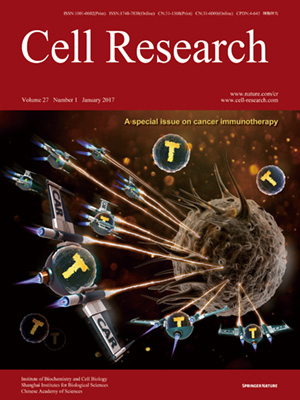
Volume 27, No 1, Jan 2017
ISSN: 1001-0602
EISSN: 1748-7838 2018
impact factor 17.848*
(Clarivate Analytics, 2019)
Volume 27 Issue 1, January 2017: 151-153
LETTERS TO THE EDITOR
Structural basis of anti-PD-L1 monoclonal antibody avelumab for tumor therapy
Kefang Liu1,2,*, Shuguang Tan3,*, Yan Chai3, Danqing Chen3, Hao Song4, Catherine Wei-Hong Zhang5, Yi Shi3, Jun Liu1,2, Wenjie Tan1,2, Jianxin Lyu1, Shan Gao6, Jinghua Yan7, Jianxun Qi3 and George F Gao1,2,3
1College of Laboratory Medicine and Life Sciences, Wenzhou Medical University, Wenzhou, Zhejiang 325035, China
2National Institute for Viral Disease Control and Prevention, Chinese Center for Disease Control and Prevention (China CDC), Beijing 102206, China
3CAS Key Laboratory of Pathogenic Microbiology and Immunology, Institute of Microbiology, Chinese Academy of Sciences, Beijing 100101, China
4Research Network of Immunity and Health (RNIH), Beijing Institutes of Life Science, Chinese Academy of Sciences, Beijing 100101, China
5ImmuFucell Biotechnology Co., Ltd., Beijing 100102, China
6CAS Key Laboratory of Bio-medical Diagnostics, Suzhou Institute of Biomedical Engineering and Technology, Chinese Academy of Sciences, Suzhou, Jiangsu 215163, China
7CAS Key Laboratory of Microbial Physiological and Metabolic Engineering, Institute of Microbiology, Chinese Academy of Sciences, Beijing 100101, China
Correspondence: George F Gao, Tel: +86 10 64807688
E-mail: gaof@im.ac.cn; Jianxun Qi, Tel: +86 10 64807417 (jxqi@im.ac.cn)
Monoclonal antibodies (mAbs) blocking immune checkpoint molecules, especially programmed cell death 1 (PD-1) and its ligands programmed cell death 1 ligand 1 (PD-L1) and ligand 2 (PD-L2), are currently been investigated for treatment of various tumors1,2,3. PD-L1 and PD-L2 are usually upregulated on the surface of multiple tumor cells to mediate immune tolerance through the interaction with inhibitory PD-1 molecule4.
10.1038/cr.2016.102
FULL TEXT | PDF
Browse 3032


